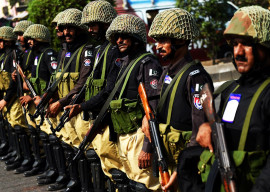
This was revealed in the 17th annual report on urbanisation by the Mahbub ul Haq Human Development Centre (MHHDC). The report was launched at a ceremony held at the Sayeed Saigol Auditorium of the Lahore University of Management Sciences (LUMS) on Thursday.
“While the region is currently the least urbanised in the entire world - only a third of population living in the cities - the rate at which it is urbanising is among the fastest in the world,” the report stated.
The report offered data and analysis of the main urban centres of South Asia, including New Delhi, Mumbai, Karachi, Dhaka, Kolkata and Colombo, in terms of the challenges and opportunities created by urbanisation.
The report indicated that urbanisation in the South Asian region had been rapid, but unplanned. “The urban population in small and medium cities has been declining. The increase in urbanisation is attributed to natural increase in urban population and rural-urban migration,” the report said.
It identified disparities within urban centres in terms of access to key infrastructure and services, including water, housing, sanitation, health, education and public transport. It also pointed towards decay of urban environment in South Asia’s mega-cities owing to urbanisation.
“Improper solid waste management, high and hazardous levels of air and water pollution and shortage of clean drinking water are major challenges facing urban centres,” the report said.
The report suggested that urban governance in the region should address issues of decentralisation of power and improving the quality of urban environment.
“Unplanned and disorganised urbanisation, compounded with pollution, congestion and inadequate basic services, can turn it into a nightmare,” said MHHDC president Khadija Haq.
She said that the biggest challenge resulting from urbanisation was the formation of urban slums. “Urbanisation in this sense can be a source of accentuating poverty and inequality, which can become a breeding ground for social conflict,” Haq said.
She added that the report shed light on the opportunities urbanisation presented in terms of economic growth and human development.
“The nature of migration has changed significantly, especially over the past few decades,” said Urban Resource Centre Chairman Arif Hassan.
“Migration is no longer a matter of choice. We now have forced migration in some areas,” he said. Hassan said that there had also been a marked change in the society.
“The number of nuclear families has increased phenomenally. A similar trend is observed in the number of women enrolled in higher education and the number of court marriages. The dynamics of the society have changed so much that the real issue comes down to where the society is going. The question is: can we work with what we have and then formulate our plans instead of the other way round?” he said.
“The challenge is how the academia can help resolve these challenges,” he said.
LUMS Vice Chancellor Sohail Naqvi said that it was vital to ensure that urbanisation was headed in the right direction. “Without effective and adequate planning, urbanisation turns into a nightmare. This is not something we need to imagine,” he said.
Urban Unit Director Dr Nasir Javed called urban development negative. “In Pakistan, we are urbanising, but in the wrong way. The number of unserved people has doubled over the past few decades as a result of this,” he said.
“The major challenge is to tackle the mindset which failed to acknowledge the opportunities associated with urbanisation along with infrastructure and service delivery. We are focusing only on infrastructure,” he said.
Javed said there were less than 150 urban planners in the Punjab.
“There are many opportunities with respect to urbanisation. A young population is living in intermediate and small cities. We need to create infrastructure for these cities and make institutions workable by learning from global examples,” he said.
Published in The Express Tribune, September 19th, 2014.







































COMMENTS
Comments are moderated and generally will be posted if they are on-topic and not abusive.
For more information, please see our Comments FAQ